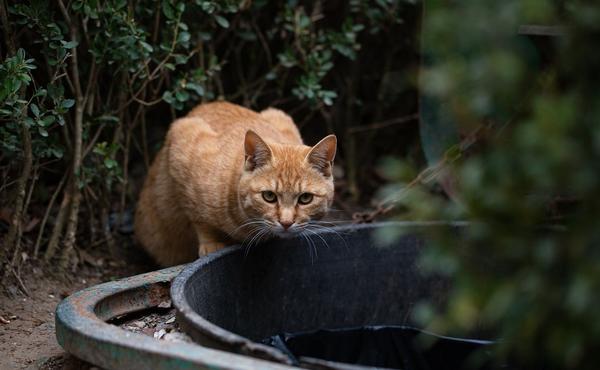Will Your Cat Come Back if You Let Him/Her Outside?

Picture this:
You let your beloved cat venture into the great outdoors, but now you're ready to tear out your hair with worry. 😟
Will he ever come back?
Has he ditched you for good?
Take a deep breath and keep reading.
Can Cats Find Their Way Home if Lost?
Cats find their way home using their strong sense of smell and scent markers left along their path. They have an innate instinct that guides them back to familiar territory.

While most cats can find their way back home, not every cat will return, especially if they are startled or chased away. Factors like outdoor experience and familiarity with the surroundings play a role in whether a cat will come back.
If your cat goes missing, it's a good idea to check nearby areas thoroughly as many cats tend to hide close by. Most often, cats return on their own without needing vocal calls or extensive searches. However, you can gently call their name and reward them upon their return.
If your cat hasn't returned within a reasonable timeframe, take additional steps like putting up posters, alerting neighbors, or contacting local shelters and veterinary offices. Searching for a lost cat requires immediate action. Time is of the essence.
Main points I'll expand upon further down this article:
- Wait 2-3 weeks (up to 4-6 weeks) before letting your cat outside.
- Age is important in determining readiness for outdoor exploration.
- Risks of letting cats outside include car accidents, catfights, diseases, and getting lost.
- Microchipping and using a cat leash can increase chances of being reunited if lost.
- Spaying/neutering and preparing the yard can mitigate risks and ensure safety.
- Training involves gradual introduction to the outdoor environment and building trust.
- Most cats will return home if introduced gradually and safely.
- Creating a secure and stimulating environment at home reduces desire to escape.
- Outdoor time allows cats to exercise, hunt, and display natural behaviors.
- Distance lost cats travel varies with a median of about 315 meters.
And now, let's discuss the importance of gradually introducing outdoor access to ensure your cat's safety and readiness.
How Long to Wait Before Letting Your Cat Outside?
When you're thinking about letting your cat outside, timing is key:
- Start by gradually introducing outdoor access to your cat. Take them out under supervision in a secure area so they can get used to it.
- Wait for about 4-6 weeks after bringing your cat home before allowing them outside. This gives them time to adjust to their new surroundings.
- Consider your cat's age. If they're kittens, wait until they're around 4 months old, vaccinated, and neutered before they venture outside.
- Even if your cat used to be an outdoor cat, give them a few weeks to settle into their new home before you let them roam outdoors.
- Safety first! Wait for 2-3 weeks before letting adult cats go outside. This will ensure they have adjusted well to their new environment.
- Be patient and watch for signs that your cat is ready, like increased confidence and curiosity.
- Never forget to put a safe breakaway collar with identification tags on your cat before you let them out.
- Make the outdoor space friendly for your cat. Add hiding spots, cat-friendly plants, and make sure the fencing or enclosures are secure.
- If you want more control over your cat during outdoor adventures, consider using a cat harness and leash. 😺
- Keep an eye on your cat's behavior outdoors and make any necessary adjustments or precautions to keep them safe.
Every cat is unique, so make decisions based on their personality and needs when deciding if it's time for them to explore the great outdoors.
Risks of Letting Cats Outside
Cats really love being outside, no doubt.
But there are risks involved in letting your furry friend roam freely in the great outdoors.

You know, they can come across some pretty dangerous predators like coyotes and birds of prey out there.
So, you need to be aware of the wildlife in your area and take precautions to keep your cat safe. Here are some other risks you should think about:
- Cars: Unfortunately, getting hit by a car is one of the top causes of death for outdoor cats. So, try to keep them away from busy roads whenever you can.
- Catfights: Outdoor cats are more likely to get into fights with other territorial felines. This can lead to injuries that might require medical attention.
- Diseases and parasites: Fleas, ticks, worms, and diseases like FIV or FeLV are just waiting outside to pounce on your cat. Keeping them indoors can greatly reduce their exposure to these nasties.
- Getting lost: Cats have a talent for wandering off and sometimes even getting lost. That's why it's essential to microchip your cat and make sure they have a collar with identification details.
- Spaying/neutering: Not only does this prevent unwanted kittens, but it also reduces your cat's urge to escape and explore the unknown beyond your front door.
Every cat is different, so consider what your individual furball needs before deciding whether to let them go outside or not.
And if you do choose to let them out, supervise them, provide proper shelter, give them all the necessary vaccinations, and always keep potential dangers in mind.
That way, you can ensure their safety and well-being.
Training Your Cat for the Outdoors
When training your cat for the great outdoors, here are 15 steps that can help you out:
- Start off on a positive note by rewarding good behavior.
- Show your cat some love with treats and kind words when they come back inside.
- Ease your furry friend into the outdoor scene with a nifty cat flap.
- Let them explore at their own speed and comfort level.
- Before allowing supervised outdoor access, ensure kittens are older than 4 months, neutered, vaccinated, and comfortable indoors.
- Create a strong bond and trust with your cat to prevent them from running scared.
- For shy cats, begin with limited outdoor time and gradually increase it as they get more confident.
- Slow but steady wins the race - introducing your cat to the outside world bit by bit is vital for their safe return home.
- Skip the harness or carrying your cat outside - those things can stress them out and create negative associations.
- Reward your cat's successful returns after expanding their territory slowly. Positive reinforcement works wonders.
- Teach your feline pal to come running to you when called by using tasty treats as a motivation.
- Keeping calm, staying consistent, and focusing on positive reinforcement are key to success.
- Wanna take your kitten for a walk? You can leash train them under careful supervision and gradual introduction.
- Make your home a zen oasis for your cat - think relaxation, security, and lots of stimulation.
- When venturing outdoors, always prioritize safety with proper identification, leashes, supervision, and secure spots.
You will encourage your cat to stay near home by creating a close connection and offering a secure outdoor area.
Benefits of Letting Your Cat Outside
Outdoor exploration gives cats the chance to embrace their natural instincts—climbing, hunting, and playing—which brings immense joy and improves their in essence wellbeing.
Cats possess an inherent desire to explore and uncover the secrets of the world around them, making outdoor adventures crucial for their happiness and contentment.

Outdoors, they have the freedom to hunt, exercise, keep their minds sharp, and showcase their innate behaviors.
Nevertheless, you have to acknowledge that indoor cats can also lead fulfilling lives with suitable enrichment and stimulation.
So whether your feline companion takes to the great outdoors or stays within the safety of your home, be sure to prioritize their happiness above all else.
How Far Do Cats Roam When Lost?
When a cat goes missing, it can be quite distressing.
You might find yourself wondering how far they could have traveled from home.
Well, let me shed some light on the subject.
- Disoriented or scared cats often stick within a small radius of their disappearance point, sometimes even just a few houses away. So be sure to search nearby first.
- However, there are cases where lost cats go on quite the adventure. Some reports suggest that cats can roam up to 5-10 miles per day. That's quite a journey for our feline friends!
- Still, it's important to note that every cat is different, and their wandering tendencies can vary. Studies show that the median distance a lost cat covers is around 315 meters. So don't panic too much!
- To increase your chances of finding your furry friend, it's crucial to act quickly. Start by scouring the immediate area, but also expand your efforts farther out if needed. Keep in mind that time is of the essence.
- Don't forget to leverage technology and social media to spread the word about your missing cat. Sharing their photo and a description online through platforms like Facebook groups or neighborhood apps can greatly aid in the search.
So the next time you find yourself with a missing cat, remember that they may not have gone very far. But it's always best to act promptly and utilize all available resources to bring them back home safely.
Wanna know MORE? Further down the blog post, I'll share some valuable insights about things to consider before letting your cat outside. So keep reading to ensure you have all the important information on hand!
But there's more you can do to increase the chances of your cat returning. I recommend utilizing familiar scents and reaching out to online communities for support in your search:
Top Hints for Locating a Missing Cat
Here's how you can find your missing cat:
- Stick some stuff with your cat's smell outside, like their bedding or used litter. It acts as a guide to point them back home.
- Use strong-smelling canned food and put the litter box and bedding outside. The enticing smells might lure your cat back.
- Get involved in online communities of cat lovers. Ask for advice, share experiences, and seek help from others who've been through this too.
- Reach out to animal control and shelters nearby. They might have info on any found cats and can help you track them down.
- Think about microchipping your cat. It ups the chances of a speedy reunion. A tiny chip holds your contact details and makes finding a lost cat easier.
Every cat is different, so try different methods for each one.
Stay positive, stay persistent, and use these tips to find your furry friend!

And finally, when your beloved cat returns home, there are a few important steps to take.
After all the worrying, it's time to make sure they receive the care they need.
In What to Do When Your Lost Cat Returns Home, I share my expert advice on how to seamlessly transition them back into their daily routine and provide them the extra love and attention they may need.
Make sure to check out this guide to ensure a smooth reunion with your furry friend!
Things to Consider Before Letting Your Cat Outside
Before letting your cat outside, there are several important factors to consider:
- Evaluate the neighborhood layout for potential hazards.
- Assess the presence of busy roads and construction sites.
- Identify any toxic plants in the area.
- Create barrier methods or supervised outdoor spaces.
- Protect your cat from unnecessary risks.
- Ensure proper identification with tags and microchipping.
- Take precautions to prevent your cat from getting lost.
- Design a cat-friendly garden with safe stimuli.
- Eliminate potential dangers from the environment.
- Install a cat flap in the backdoor for easy access.
- Provide shelter, water, and food outside.
- Consider your cat's breed and age before making a decision.
- Certain breeds may not be suitable for outdoor environments.
- Adult cats may need an adjustment period if recently adopted.
- Monitor your cat's behavior and well-being.
- Be prepared to intervene if necessary.
With these considerations in mind, you can make an informed decision about whether to let your cat outside.
And that wraps up today's article.
Before you leave, can I ask you something? Did my blog post help you out? If it did, I would be incredibly grateful if you could share it with your loved ones. You just need to click on any of the social media sharing icons to easily spread the word. Thank you so much!
Talk soon,
-Sarah Davis